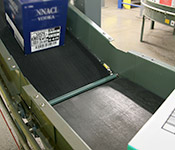
A Conveyor is Only as Good as the Belt That’s on It
David Mann | 12 December 2013
Choosing the right conveyor belt for your product is one of the most important, and often over-looked, details in the selection of a conveyor. The type of material the belt is made of is vital to the success of the application, and having the wrong belt can significantly affect throughput, downtime and safety. There are many different types of belts available so the first step in choosing the correct belt is to know your product and how it will convey. Several key points to consider are:
- The size, weight and distribution of the product
- The material the product is made of
- How the product will be loaded on the conveyor (i.e. will there be impact loading?)
- If the product’s orientation will change
- The speed the product will be conveyed
- Whether the product will travel on an incline and/or decline
- The environment in which the conveyor will operate (i.e. Is it hot or cold, wet or dry, inside or outside, corrosive, etc.?)
Once you have a good understanding of your product and the environment it will operate in, you can select the proper belt. Below are the basic belt types available. (This is not by any means an exhaustive list. There are many other specialty belts available.)
General Purpose Belts
This wide group of belting is typically made of an inner carcass and an outer cover. The materials used for these belts include rubber, PVC, Urethane, Neoprene, Nylon, Nitrile, Polyester, leather and others. Applications for this type of belting include:
- High friction for inclining/declining
- Low friction for accumulation
- Oil resistant
- Cut resistant
- Food grade
- Electrically conductive
- High temperature
- Cleated for bulk handling
- Troughed for bulk handling
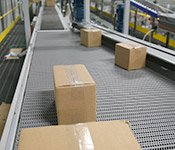 Plastic Belting and Chain
Plastic Belting and Chain
Common industry names for this type of belting include: TableTop, MatTop, Angled Roller Belting, and MicroSpan. It is often lightweight, durable and wear resistant. Applications for this type of belting include:
- Food production
- Packaging
- Pharmaceuticals
- Manufacturing
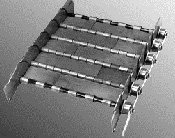 Hinge Metal Belting
Hinge Metal Belting
Hinge metal belting is incredibly durable is often used for machine chip and scrap removal. Applications for this type of belting include:
- Wet or dry operation
- High temperature operation
- Machine tool chip removal
- Whole plant chip and scrap removal
- Die cast operations
- Parts handling
- Packaging operation
- Inspection
- Stamping operation
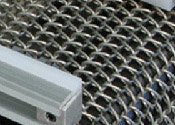 Woven Wire Belting
Woven Wire Belting
Woven wire belting is commonly used in very high/low temperature environments and during the drying process. Below are some of its many applications. Applications for this type of belting include:
- In food processing these belts are used in:
- Washing
- Baking
- Dewatering
- Blanching
- Cooking
- Freezing
- Pasteurizing
- In glass and ceramics it is used in:
- Firing
- Decorating
- Enameling
- Annealing
- Fiberglass curing
- In electronics it is used in:
- Glass to metal sealing
- Thick film firing
- Drying of printed circuit boards
- In metalworking it is used in:
- General conveying
- Heat treating
- Quenching
- Annealing
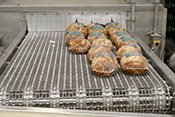 Flat Wire Belting
Flat Wire Belting
As its name suggests, flat wire belting has a flat surface making it ideal for food handling. It is more economical at time compared to woven wire belting. Applications for this type of belting include:
- Canning and food preparation
- Baking and freezing food
- Parts cleaning
- Parts painting and drying
- Product sorting, assembly and packaging
- Parts transfer
Once you have selected the appropriate type of belt, be sure to also consider the specifics of how the belt can be cleaned and maintained, replaced or modified, and the costs associated with these. Again, this is not intended to be a complete list of conveyor belting, but is a guide to the most common types used in the industry today. If you have questions about which type of conveyor belt is right for your application, please contact me anytime.
Comments
Stefanie Hardy says:
8/28/2018 10:09 AM
Josh, I posed your question to one of our senior project engineers, Bill Galbraith, and this was his response: Not many belt manufacturers mark their belts with their name or the style of the belt. The only suggestion I would have would be to contact the supplier of the conveyor and see if they would tell you the belt manufacturer that they supplied. Regarding the actual length of a belt, I would suggest using a piece of string and run it through the belt path. There are formulas that the conveyor manufacturer uses, but the most accurate would be the string method.
Please feel free to give us a call if you need help or have more questions, (800) 772-0464.
Bhupendra Rathore says:
8/28/2018 10:09 AM
Which Type Of Conveyor Belt Is Required For Coal Handling System?
Dave Bhaarat says:
8/28/2018 10:09 AM
i am working on making a machine for metal coating and drying about 120 degree temp. & for that i want to choose best material for wire mesh conveyor which has less cost and more life. so what should i choose between m.s. and s.s.
Leave a Reply
Your email address will not be published.
Comment
Thank you for your comment.